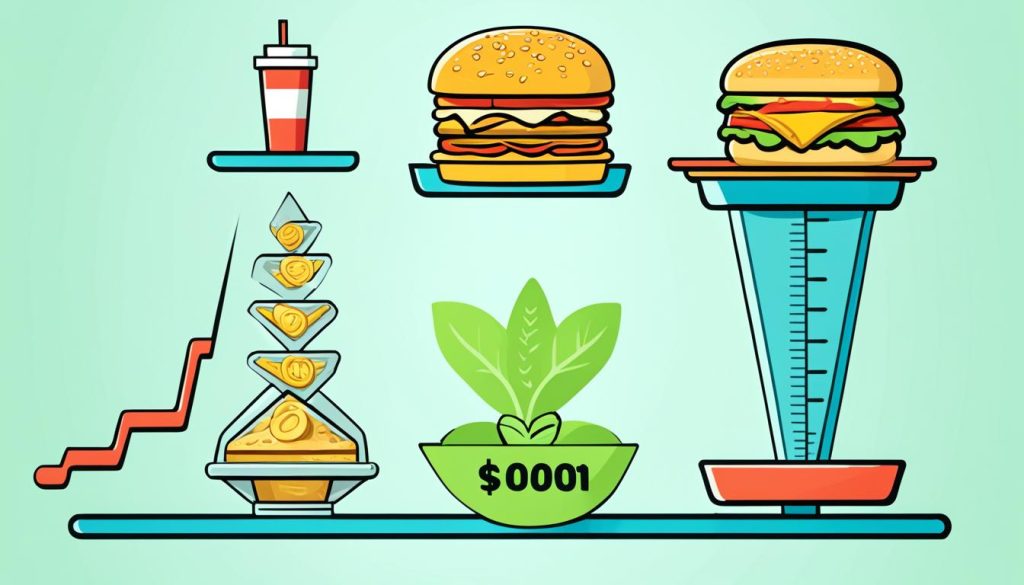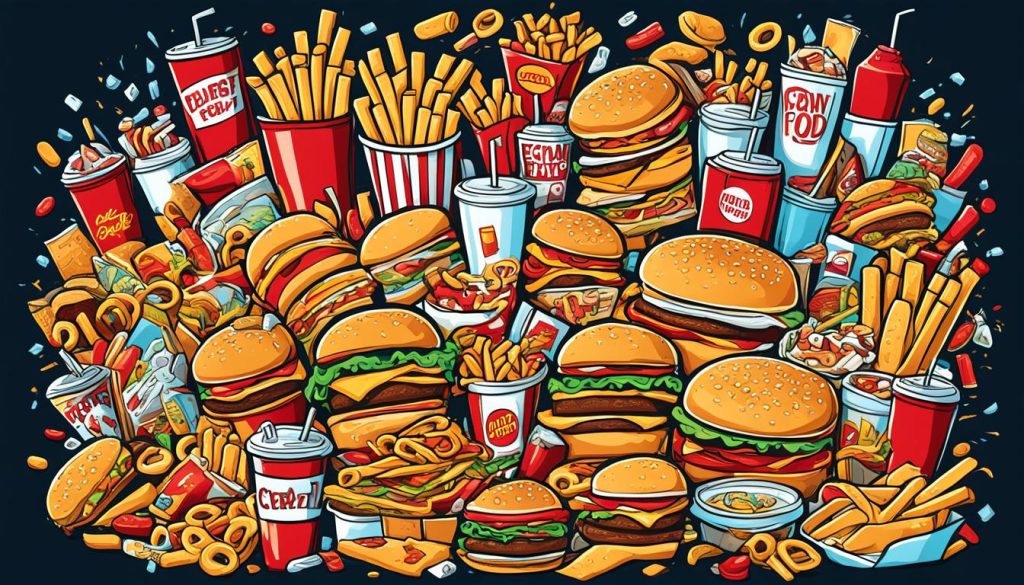Fast food is a big part of the American diet, with 36.6% of adults eating it daily in the U.S. from 2013-20161. It’s easy and often cheap, but its real cost goes way beyond the price. Understanding the financial and health effects of fast food is key to making better food choices and living healthier.
The growth of fast food and supermarkets has changed how we eat, leading to more obesity2. These places make it easy to grab food on the go, affecting the health of young to middle-aged adults2. Knowing how the food environment affects your eating habits is vital for your health.
Eating a lot of fast food can harm your health. These foods are high in calories and can make you gain weight. This increases the risk of serious health problems like heart disease and type 2 diabetes. Treating these diseases adds to the cost of fast food, with medical bills piling up.
The food industry, including fast food, is a big source of global emissions, making up about one-quarter of them3. Eating more sustainably is good for your health and helps reduce environmental damage from the food industry.
Key Takeaways
- Fast food is eaten by 36.6% of U.S. adults on a daily basis1.
- The growth of fast food and supermarkets has led to more obesity and changes in eating habits2.
- Eating a lot of fast food can cause weight gain, increase the risk of chronic diseases, and lead to high medical bills.
- The food industry, including fast food, is a major source of global emissions, showing its environmental impact3.
- Choosing sustainable food options can improve your health and help the environment.
The Prevalence of Fast Food Consumption
Fast food is a big part of the American diet. Many people eat it often. The National Health and Nutrition Examination Survey (NHANES) from 2013-2016 found 36.6% of adults ate fast food one day a week in the U.S4.
This habit is more common among the young. 44.9% of adults between 20-39 ate fast food, while 37.7% of those 40-59 did, and 24.1% of those 60 and older4.
Key Statistics on Fast Food Consumption in the United States
Fast food eating varies by group in the U.S. More non-Hispanic black adults (42.4%) ate fast food than non-Hispanic white (37.6%), non-Hispanic Asian (30.6%), and Hispanic (35.5%) adults4. Eating fast food was more common with higher family incomes4.
Fast food eating is a big health worry, especially for the young and some racial groups4. 72.4% of high school students ate fast food in the last month4. Obesity rates are high, with 21.3% by BMI and 33.2% by WHR4.
Some fast food items like sandwiches, fried chicken, and pizza are linked to being overweight or obese4. Eating these foods is tied to a higher chance of being obese or overweight4.
Over 30 years, fast food has become a bigger part of our diets4. Now, over 33% of adults are obese, and many kids and college students eat fast food every day4.
Fast food’s link to weight gain and obesity is a big health worry4. Being overweight or obese raises the risk of many diseases, leading to a lot of lost years of life4.
The True Cost of Fast Food: Financial and Health Implications
Fast food is tempting with its quick service, low prices, and tasty flavors. But, its real cost goes way beyond what you pay at the cash register5. It affects both your wallet and your health, impacting you and everyone around you.
Fast food is a big worry for public health. Eating it often is linked to obesity, diabetes, and heart disease6. It’s full of calories, fat, and sodium, which can make you gain weight and lead to poor eating habits.
These health issues can lead to huge medical bills6. Diseases like heart disease and diabetes are becoming more common. The cost of treating these conditions is more than what we’ve spent on recent wars6. This hurts families, the healthcare system, and the economy.
Fast food’s impact isn’t just on our health5. It also affects society in ways we don’t see at first glance5. For example, the trash from fast food packaging adds to our environmental problems.
Figuring out the full cost of fast food is hard because it’s a big and complex issue5. But if we knew the real cost, people might eat less fast food. This could lead to a healthier and more sustainable food industry.
The real cost of fast food is more than just the price. It affects your wallet and your health in big ways. As consumers, knowing the real costs can help us make better choices. This way, we can pick what’s good for our health and the planet.
“The true cost of fast food is much more than just the price paid for a cheeseburger.”
Socioeconomic Disparities in Fast Food Access
How Income and Race Impact Fast Food Habits
Studies show a strong link between income, race, and fast food eating. The National Health and Nutrition Examination Survey found that more people eat fast food as their income goes up. For example, 31.7% of those with lower incomes eat fast food, while 42.0% of those with higher incomes do7.
Also, more non-Hispanic black adults eat fast food than other groups, at 42.4%7. These facts show how income and race affect fast food habits.
These differences in fast food access and eating habits lead to health and economic inequalities. We need to focus on improving the social factors that affect healthy eating7. Research shows that fast-food places are often in low-income and minority areas8. Also, the availability of healthy food in restaurants depends on the area’s race and wealth8.
Fast-food outlets in poor areas can harm health. People living near these outlets tend to have a higher BMI than others9. This effect is not lessened by the presence of healthier food options9.
We must tackle the social factors that affect health and make sure everyone has access to healthy food. By understanding and fixing these issues, we can aim for a fair and healthy food environment for everyone789.
“Worldwide, the adult prevalence of overweight and obesity has tripled from 13% in 1975 to 39% in 2016, and the presence of fast-food outlets may exert negative health effects.”9
We must deal with the obesity crisis and chronic diseases by addressing their root causes. We need to create a food environment that is fair and promotes health for all.
The Role of the Food Environment
The food environment around us affects what we eat and how often. Studies show that having fast food places and convenience stores nearby can lead to eating more unhealthy foods. This can make people more likely to be overweight and have health problems10. On the other hand, having places to buy healthy food can help people make better food choices10.
Fast food places in some areas make it easy to eat unhealthy. For example, a study found that a college campus had many fast-food spots, leading to a lot of unhealthy food sales10. This can make students and others in the area eat more junk food, which is bad for their health.
But, areas with more grocery stores and healthy food options tend to have fewer fast food places10. Research shows that people who live in these areas eat healthier and have better health scores10.
Understanding how the food environment affects our eating habits is key to improving public health10. By knowing how food choices are linked to health and cost, we can make better food environments10.
“The food environment can either promote or hinder healthy eating behaviors, and addressing its role is essential for tackling the obesity epidemic and other diet-related health issues.”
Dealing with the obesity crisis and its costs means looking at the food environment’s big role10. By making sure there’s easy access to healthy food and fewer fast food spots, we can help people eat better10.
Strategies for Healthier Food Choices
To fight the rise of processed foods and lifestyle diseases, we need a strong plan. By giving people the right knowledge and access to healthy food, we can push for better eating habits11.
Improving fast food menus and making calorie and nutrient info clear can help people choose better12. Also, bringing supermarkets and fresh food to poor areas can fix the lack of healthy food access11.
Telling people how fast food affects their health and wallets is key. Showing the good side of eating whole foods is also important12. Programs like the Gus Schumacher Nutrition Incentive Program help low-income folks get more fresh produce11.
By making healthy food easy to get and use, we can help people choose better. This leads to a healthier food system111213.
| Strategy | Description |
|---|---|
| Improving Fast Food Nutrition | Enhancing the nutritional quality of fast food menu items and providing clear calorie and nutrient information to consumers. |
| Increasing Access to Healthy Foods | Attracting supermarkets and fresh produce sources to underserved communities, addressing disparities in access to affordable, healthy foods. |
| Public Education and Incentives | Educating the public on the financial and health implications of fast food, as well as providing financial incentives to encourage the use of SNAP benefits at farmer’s markets. |
“Sustainable eating is not just about individual choices, but also about creating a food system that prioritizes health, equity, and environmental stewardship.”
By tackling the big reasons why people eat fast food, we can help them pick healthier and more sustainable foods. This leads to better health and less money spent on diseases linked to eating habits111213.
Conclusion
The U.S. spends a lot on fast food, which has big financial and health costs14. Fast food burgers seem cheap but have hidden costs like grain subsidies and greenhouse gas emissions14. The real cost of food is about three times what we pay at the store14.
Fast food is linked to more calories, fat, and sodium, and it makes people obese15. This affects 42 percent of American adults, or about 109.5 million people15. The cost of diseases from eating too much fast food is huge, at $16 trillion from 2011-202015.
We need to make food choices healthier and teach people about them14. Changing the food system can help reduce the health and financial problems of fast food14. Eating more plant-based foods can also help the environment14.
FAQ
What is the prevalence of fast food consumption in the United States?
How does fast food consumption vary by socioeconomic factors?
What are the financial and health implications of fast food consumption?
How does the local food environment impact fast food consumption?
What strategies can be implemented to encourage healthier food choices?
Source Links
- Products – Data Briefs – Number 320
- Global growth of “big box” stores and the potential impact on human health and nutrition
- True cost accounting in agri-food networks: a German case study on informational campaigning and responsible implementation – Sustainability Science
- Fast food consumption and overweight/obesity prevalence in students and its association with general and abdominal obesity
- Opinion | The True Cost of a Burger (Published 2014)
- The True Cost of Junk Food
- Sociodemographic differences in fast food price sensitivity
- Neighborhood Disparities in Access to Healthy Foods and Their Effects on Environmental Justice
- The association between the presence of fast-food outlets and BMI: the role of neighbourhood socio-economic status, healthy food outlets, and dietary factors – BMC Public Health
- A College Fast-Food Environment and Student Food and Beverage Choices: Developing an Integrated Database to Examine Food and Beverage Purchasing Choices among College Students
- Access to Foods That Support Healthy Dietary Patterns – Healthy People 2030
- Actions for Healthy Eating – Local Government Actions to Prevent Childhood Obesity
- Healthy Food Environment Recommendations: Complete List
- True Cost Of Food: What We Measure, Matters
- The Economic Costs of Poor Nutrition – AAF


